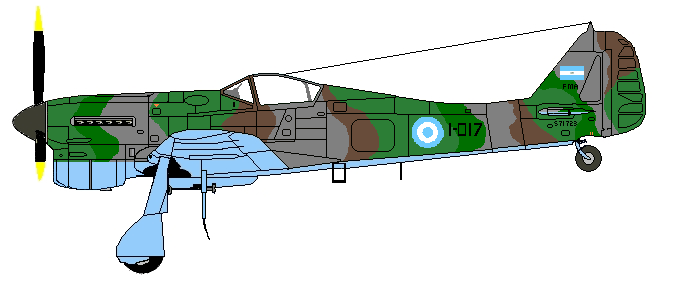Noticias Argentinas
January 6
Today the famous fighter pilot, Lieutenant de Aero Roja, on loan to Fabrica Militar de Aviones (FMA) took the new prototype FMA I-02 fighter up for its first flight. The unpainted polished silvery prototype was rolled out of the works hangar after some minro last minute adjustments. The thirty-two minute flight revealed no serious problems although Roja complained the ailerons were too heavy but the engine performed without any problems. He found the long nose tricky for ground handling but in the air he praised the excellent visibility from the canopy. Developed from scratch as a modern fighter the I-02 is heavily based on war experience and rectifying faults in the I-01 series. An order for 144 aircraft has already been placed to equip two fighter Regiments.
Provisional specifications for the fighter are;
Dimensions: span 10.6m; length 10.3; height 3.42m; wing area 197sq ft; wing loading 38 lb/sq ft; power loading 0.17 lb/hp
Weights: maximum take-off 7,500lbs
Powerplant: one 1300hp Spartan 1300S V-12 inline engine with supercharger
Performance: max speed 400+ mph at 15,000 feet; service ceiling 35,000ft; rate of climb 2,598ft per minute at 1,500ft; range 690 miles full fuel load
Armament: four 13mm Browning HMG in wings and a ventral bomb-rack for one 250-500lb bomb

An artist's impression of a production I-02 fighter
January 11
The Nationalisation Investigation Committee met for the first time today in Cordoba to fully discuss the government’s plan to nationalise the oil and steel industries. Outside around a hundred trade union members held a demonstration in favour of the proposal. The police broke the crowds up and some minor scuffles broke out in which ten demonstrators were injured. Unions claim police brutality.
January 12
Union demonstrations are joined by striking transport workers and the police set up roadblocks in the city and Guardia Civil units were called in. Rather than advancing to break up the crowds they turned a blind eye as a group of right-wing activists waded into the demonstrators. Four men are killed and forty others injured.
January 13
Violence continued today outside the Chamber of Deputies building and Labour and Industry Minister Carlos Saavedra Lamas left the meeting to plead with the crowd to go home but failed to impress them. In the afternoon President Eduardo Garcia blamed the violence on Marxist trouble makers and ordered the Guardia Civil to break-up the strikes. They used tear-gas and batons and many were injured. Across the capital and western Argentina around forty suspected Marxists were arrested and held for questioning.
January 14
The demonstrations of the past few days have broken up but a heavy police presence remains across the capital.
January 20
After joint talks with Chile it has been decided to rebuild the meter-gauge (1000mm; 3 ft 3+3/8 in) Central Transandine Railway which runs from Valparaiso in Chile to Mendoza, Argentina. Chile had been in discussions with Swiss engineers who will take responsibility for rebuilding and upgrading of the Chilean side of the railway in order to minimize the steep gradients. A new tunnel will connect the Chilean and Argentine broad-gauge railways with a technologically challenging design which will result in the second-longest railway tunnel in the world (after the Simplon Tunnel) and this work is being carried out by British engineers who have recently completed the Woodhead Tunnel in England which is two-tracks wide and 3 miles 66 yards long under the Pennines. British investors are matching whatever funds the Ministry of Transport pledges towards the project and the Argentine State Railways is looking into new locos and carriages for the route. It is possible that British shares in the former Transandine Railway Company will be brought back by British investors from the Argentine State Railways to operate the line on completion. Work on the railway lines will begin within two months and the whole project is scheduled for completion in 1942/43.

